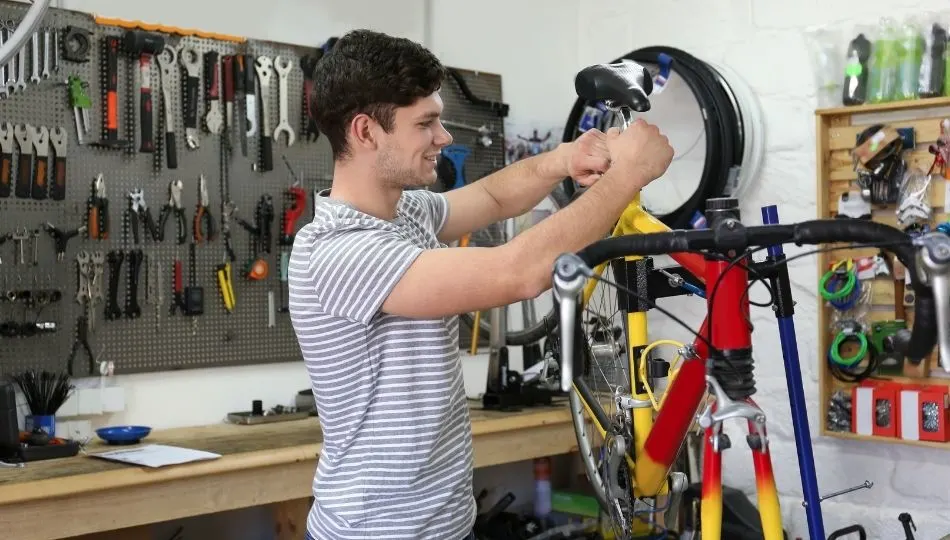
When I first started cycling, all I had was my bike and a backpack. And this is fine if you’re only biking once in a while, but once you start cycling regularly, bike maintenance becomes essential. And if you’ve walked into any local bike shop, you may have noticed the overwhelming minefield of tools and kit that are available.
The essentials for bike maintenance come in 2 categories:
- Tools that maximize bike performance & ensures everything works smoothly & properly
- Tools that repair or alter a bike’s components when they break or need adjustment
Both categories are equally important for proper bicycle maintenance.
So, I’ve written a comprehensive guide on all the essentials you need to keep your bicycle in tip-top shape. This guide will help you find what kind of tools are right for you, and which ones you could easily live without. I’ll also go through:
- What you should look for when purchasing bicycle maintenance essentials
- Where you should purchase them from
- What you need and what you really don’t
Essentials to Maximize your Bicycle’s Performance
Let’s take a look at the first category of tools we need to be thinking about; what you need to make sure your bike is in good working condition. The following tools are what I would consider every cyclist should have at their disposal:
NOTE: Don’t make the mistake I did and wait until you hit an emergency before you think about getting these tools; when you need them, you really do need them!
Air Pump
Like any person needs food and water to function to the best of their ability, your bicycle needs air for its wheels to turn properly. And you need to fill your tires with air regardless of whether you get a puncture or not.
Eventually, the tires will become flatter, and you’ll need to pump them up so that it is easy, comfortable, and safe for you to ride.
So, what are you looking for in a pump? Well, you should know that there are a lot of bike pumps on the market that are very tedious and annoying to use, so don’t choose one of those!
These are the two types of pumps that are strongly recommended and are worth looking into:
1. Floor Pumps
As its name suggests, because these pumps rest on the floor, they make your pumping job much easier. They are usually designed with a hand pump that is easy to use and a gauge with which you can easily see your bicycle tires’ pressure.
Here’s an example of a really good floor pump on Amazon. It’s great value and has all the useful features you’d want in a pump.
It is manufactured with a steel beam to ensure that the structure is strong and stable and it’s easy to switch between the different valves. It also has a large pressure gauge, which is really useful for checking while pumping.
TIP: When a pressure gauge is too small, you’ll always have to stop halfway to look closely at the gauge and check the pressure. A large one saves time as you can easily see it while you are pumping.
2. Electric Bicycle Pumps
If you want to avoid the physical exhaustion (in some cases) of manually pumping your bicycle’s tires, you may want to consider using an electric bicycle pump.
Many electric pumps are designed to be capable of pumping air into other kinds of tires (including car tires) as well as inflatable sports equipment like rafts and floaters.
Aside from avoiding the hassle of tiring out your arms, having an electric bike pump also saves you a lot of time from constantly checking whether your bicycle tires are fully pumped.
Many of these electric bicycle pumps are designed with automatic sensors that will shut off the pump when your bicycle has reached sufficient tire pressure.
This is an example of a good electric bicycle pump from Amazon. Pumps like this are usually small enough to keep in your bicycle compartments, meaning that you can bring them with you wherever you may need them.
The pump also uses a digital pressure gauge that makes it so much easier to check your tire pressure. They use a lithium-ion battery that is rechargeable with a simple micro-USB cable, which can be found in almost any household nowadays, making them extremely easy to charge.
How To Choose a Bicycle Pump
Now that you are aware of the best options that are available in the market, how do you decide which air pump to choose for your bicycle?
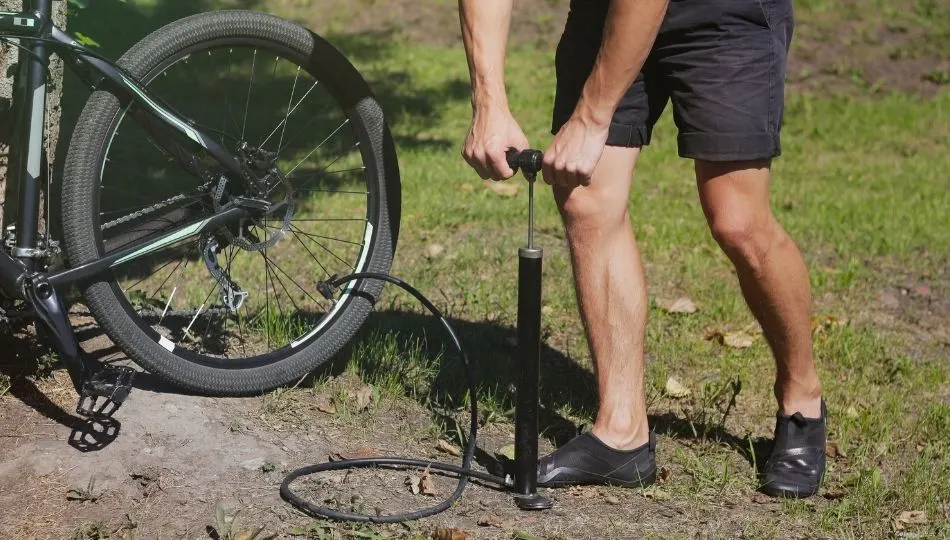
Like any other bicycle component, there are a few things to consider when you look into purchasing a bicycle pump. Let’s take a look at them.
Pressure
Depending on the type of bicycle you ride, there are different pressures of pumps you may opt for. Generally, most regular road bicycles do not need a pump that extends beyond 260psi and most mountain bikes are usually capped at 40 psi.
NOTE: Narrower bicycle wheels (like those on road bikes) require higher pressure and wider bicycle wheels (like those of mountain bikes) require lower pressure. So make sure the bike pump is in line with the type of pressure your tires need before buying.
Gauge
It is recommended that you invest in a pump with a gauge that is both easy to read and accurate. Accuracy is important as it helps maintain the right tire pressure, improves traction and speed, and contributes to a longer tire life. A decent bike air pump should also offer a pressure range that is suitable for your needs.
Brushes
When it comes to cleaning and dusting off your bicycle, brushes are your bread and butter. In comparison to everyday household items like cloths and rags, brushes allow you to clean hard-to-reach places and the little nooks and crannies of your bicycle parts.
Not to mention, they also make the job faster and easier. Brushes usually come in sets that you can purchase, which are designed for different purposes when it comes to bicycle cleaning.
For example, the brush set linked above includes a large frame brush that can be used to clean and brush off places such as your bicycle’s frame and bicycle’s derailleurs.
It also includes a long brush that is used to clean the more intricate parts of your bicycle, such as spots on your bicycle’s hub body and the chainstay.
How to Choose a Brush Set
When it comes to the world of bicycle brushes, many sets are, more or less, the same when it comes to efficiency, reliability and performance; usually, sets are not “better” than others. However, there is a general rule you should follow when searching for a good brush set for your bicycle.
Look for brush sets that come with brushes that have a variety of different shapes, sizes and bristle stiffness. While a large, soft brush may be good at cleaning your bicycle’s frame and derailleurs, the same thing cannot be said for other bicycle parts. Likewise, you also want a cone-shaped or long, narrow brush that can help you reach every part of your bicycle.
Repair Stand
Have you ever complained about how hard it is to perform maintenance on your bicycle? It shifts easily and you also cannot put too much force on the vehicle or else it either tips over or you are too afraid that you may damage its parts.
That is exactly why you need a reliable repair stand. They essentially operate as an extra pair of hands that help you stabilize and securely grip your bicycle while you “operate on it.
Bicycle repair stands usually also hold your bicycle off the ground, meaning that you do not have to break your back when dealing with your bicycle’s chain or freewheel. This is an example of a good repair This is an example of a good repair stand available at Amazon.
How to Choose a Bicycle Repair Stand
Here are the important things to consider when you look into purchasing a bicycle repair stand.
Are You Looking for a Permanent Solution or a Portable One?
When it comes to bicycle repair stands, you have two options.
- Heavy bicycle stands are designed to sit in your garage or backyard without many relocations. Because these stands are heavier, they are usually also sturdier and more stable.
- Lighter bicycle stands are easily portable even during long trips. In the case that you need to perform emergency maintenance on your bicycle on the roadside, your bicycle repair stand will be ready for use. Although they are relatively less sturdy than heavier bicycle stands, they are definitely reliable when it comes to holding up your bicycle.
How Many Bicycles Will Use the Repair Stand?
If you only plan to service your own bicycle, a normal repair stand should always be sufficient for your needs. However, if you plan on servicing many different bicycles, you may want to consider investing in a more expensive repair stand.
For example, some stands are even capable of holding up and securing two bicycles if you need to operate on two bicycles at the same time.
What Kind of Maintenance Are You Performing on Your Bicycle?
Depending on the type of maintenance you hope to perform on your bicycle, some repair stands may be better options for you. For example, if you want a stand that can handle the torque (or turning) of repairs and alterations, you probably want to invest in a large floor stand with a wide base that can support these forces.
Chain Checker
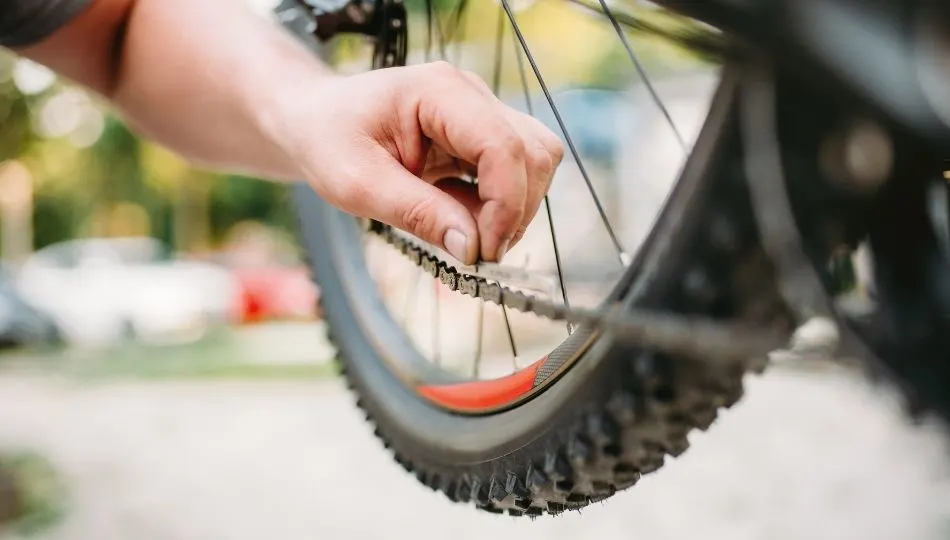
A chain checker helps keep your bicycle chain in tip-top shape and ready for whatever weather you may encounter during your ride.
For those that are not well-versed with the two-wheeled vehicle, making this distinction can be quite challenging; accurate observations only come with time and experience.
Thus, your best bet is certainly a chain checker. These tools help you determine the current condition of your chain and whether it is time for a replacement.
However, because most chain checkers fulfill the same goals and perform identical tasks, there is barely any variation when it comes to choosing the “right” chain checker. If you want a suggestion, though, this is a reliable option available from Amazon.
On top of telling you whether or not your chain is still usable, this chain checker also tells you exactly how worn down your chain is.
For those that have multiple bicycles, this is important because drivetrains with different speeds have different lifespans.
Chain Cleaner
A dirty chain can actually permanently damage your bicycle’s drive train because it can force the debris into hard-to-reach parts of the component, which greatly limits your bicycle’s shifting capabilities.
Using a chain cleaner or chain scrubber is the easiest and most efficient way to either avoid or tackle this issue. Here’s an example of an excellent chain cleaner you can use for your bicycle chain.
Seems complicated… how do I use it? Contrary to their appearance, they are actually quite simple and straightforward to use both in preparation and application. In fact, there are only 3 easy steps you need to follow:
- Fill the contraption with a degreaser or bicycle cleaning fluid of your choice
- Secure the contraption around your bicycle’s chain
- Continue to backpedal until the contraption has revolved around your entire bicycle chain multiple times or until the contraption has completely cleaned your bicycle’s chain.
This way, all the minute hard-to-reach places on your bicycle chain are also squeaky clean.
Bicycle Lubricant
In order to ensure that every component of your bicycle, including your chain, is running smoothly and efficiently, it is crucial to ensure that your bicycle chains are well-lubricated.
NOTE: Not only does it decrease friction, which increases your chain’s efficiency, a bicycle lubricant also decreases the rate at which your drivetrain wears down. In the long run, this also means that you will not have to replace your chain every so often.
Note that usually, thicker, more viscous fluids further decrease the wear rate of your chain. You definitely do not want to spend hundreds of dollars over a year replacing your drivetrain multiple times. When it comes to choosing the right chain lubricant for your bicycle, there are various types available.
Dry Lubes
Dry lubes are designed to keep your bicycle chain lubricated within hot and dry conditions, meaning long-lasting lubricant for your bicycle. They usually consist of just over ten percent lubricant and around ninety percent carrier fluid.
Because they are less viscous than some other variants, they are also more efficient due to less friction. However, they are only recommended if you live in or cycle in dry areas; dry lubes are very easily washed out by rain and snow.
This bike chain dry lube from Amazon would be a good choice because of its waterproof formula that makes it ideal for both short and long rides.
Wet Lubes
On the other hand, wet lubes are designed to keep your bicycle chain lubricated within wet and damp conditions; this also means that they largely consist of viscous bicycle fluids such as synthetic oils.
Its viscous nature also means that this type of bicycle lube will last comparatively longer than the dry lube option, even in conditions of rain or snow.
However, note that because of this same property, they can also easily attract debris when riding and also lower pedaling efficiency due to the friction it creates. Likewise, it is extremely important to remember to wipe out excess lube after applying it to your bicycle.
Here’s one that you might want to consider if you’re looking for a wet lube (Amazon link). It’s also waterproof, but much thicker, and will do just as good in long distances and extreme weather.
Ceramic Lubes
In essence, ceramic lube is manufactured with minuscule ceramic particles that some claim to lessen friction and thus, improve efficiency to a greater extent than regular lubes.
Likewise, note that this option will be a tad bit more expensive than the other options listed. However, because it lessens friction, it can actually greatly extend the lifespan of your drivetrain, which could possibly be worth your money in the long run.
This ceramic bike lube on Amazon is a great choice, even for dusty and damp conditions, because aside from providing lubrication, it also protects your bike chain from corrosion.
Wax Lubes
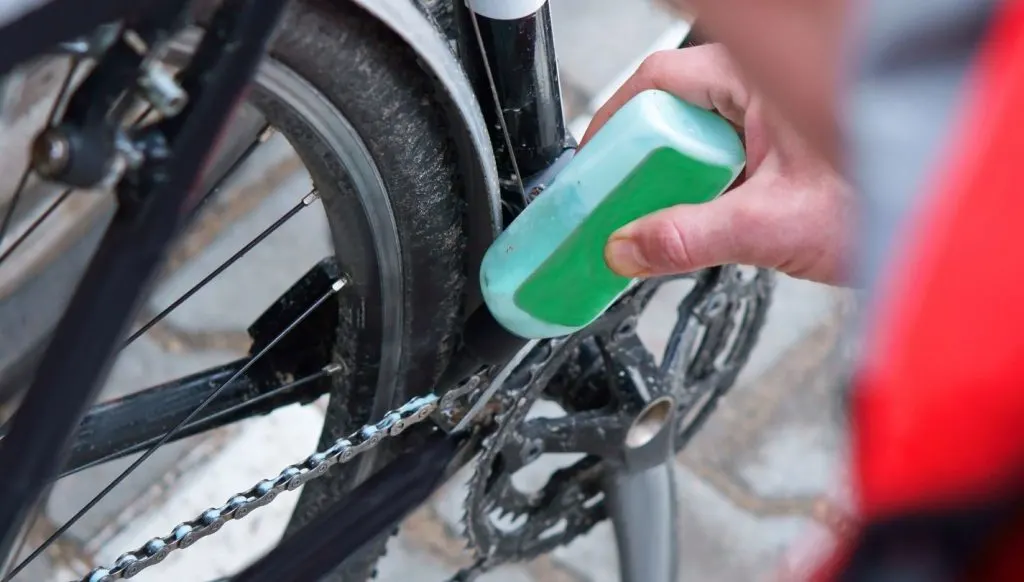
This type of lubricant has gained immense popularity over recent years due to some test results that reflect their ability to maximize pedalling efficiency, ensure chain and drivetrain condition and resilience to debris and dirt.
Generally, these substances are manufactured as a mix of wax, carrier fluids, and other additives. When applied, the substances actually turn into a hard layer of lube that sticks to the chain; this actually prevents debris and dirt build-up on your chain.
However, in order for wax lubes to take effect, your chain must be squeaky clean. Otherwise, the substance will simply not adhere to your bicycle. Further, it also must be dry before you can ride your bicycle. This is an example of a good wax lube as it works in dry, wet, muddy, and sunny conditions.
WD-40…?
Although some experts strongly discourage the use of WD-40 on your bicycle’s chain and you will for sure never see an expert or bicycle mechanic use it as a lubricant, it is actually viable, but obviously worse, substitute as a bicycle lubricant.
On top of that, it also serves as a solid cleaner for your bicycle chain as well. Although it is undeniable that it easily wears off in wet weather conditions and it does not last for very long, it still does what a bicycle lube is supposed to do: ensure a smooth pedalling experience.
Essentials for Bicycle Repair and Maintenance
Aside from improving your bicycle’s performance when it is in a good condition, as a cyclist, you must also prepare for the situations in which a component of your bicycle breaks or needs replacement.
While your regular toolbox at home can carry out some of these procedures, there are specialized tools that are made for your bicycle maintenance needs that are available on the market. Below is a list of essentials that every cyclist should have at their disposal.
Bicycle Chain Tool
A bicycle chain tool is made for the purposes of breaking apart your bicycle chain in the case that you need it to be replaced or taken off for various purposes (like cleaning).
With the same tool, you can also reattach your bicycle’s chain to your bicycle, mending it back together. Note that this procedure is actually possible using only household tools you have available to you; however, that process is significantly harder and more tedious.
REMINDER: Not all chain tools are compatible with every chain. Before purchasing a bicycle chain tool, check to see that your bicycle’s chain is compatible with the tool.
It is strongly recommended that you invest in a bicycle chain tool that is light and easily portable on trips, especially ones of long distance. In the case that your bicycle chain snaps or something goes wrong, you will be prepared for the occasion.
Otherwise, you may have to walk to a repair shop. Chain tools like this one on Amazon, are both sturdy, strong and compact, making it a very good option as a travel tool.
Allen Wrenches
Allen wrenches are the fundamental tools you need to perform any type of bicycle repair and replacement to your bicycle. Allen wrenches are absolutely essential for you to interact with the bolts and screws on your bicycle.
They are important even in the case that you want to adjust the handling of your bicycle; for example, if you wanted to slightly tighten or loosen the brakes of your bicycle.
Having a set of Allen wrenches allows you to have more freedom and control over the handling, settings, and options of your bicycle.
Open-end Wrenches
In some cases, you may need to use open-ended wrenches in the case that your Allen wrenches are not sufficient. They perform the same utilities as an Allen wrench, but they are slightly larger and, therefore, serve some slightly different purposes.
Needle-nose Pliers
In the case that you need to adjust or grip some small components on your bicycle, these pliers are your best bet.
Rotor Truer Tool
This tool is designed for the purpose of adjusting your bicycle brakes and rotors in the case that you need to tighten, loosen, align, or rotate these components. It is important to note that in the case that any of these procedures are needed, this is your only option.
REMINDER: There are no substitutes for this tool as it is designed specifically for the purposes of bicycle adjustment.
Bicycle Tire Lever
Bicycle tire levers are absolutely essential to any long-term cyclist, regardless of whether you cycle for leisure or for commute. Bicycle tire levers serve the purpose of helping you safely remove and reinstall bicycle tires onto your bicycle.
While this is, again, completely achievable with other household tools, it is strongly discouraged. Why? Those tools can severely damage your bicycle’s rim, tube, or frame.
Having a tire lever can guarantee that the process is both easy and safe for both you and your bicycle. This is an This is an example (Amazon link).
Cable Cutters
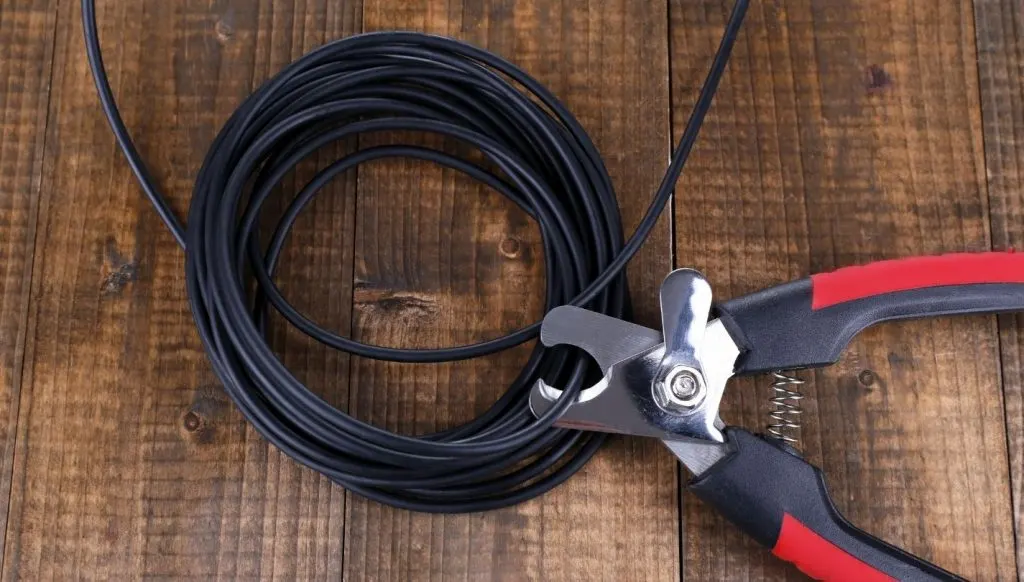
Cable cutters are made for the purpose of making the process of cutting bicycle brakes and cables easy and quick. In the case that you need to replace any of the string-like components of your bicycle, whether it is your derailleur cables, your brake cables, or even cable housing, this is definitely your best bet.
This tool ensures that all your cuts are precise and accurate. Here’s an example of one on Amazon.
Chain Whip and Cassette Removal Tool
These two tools are designed for the purpose of removing the lockring of your bicycle’s cassette and detaching it from the hub body. It can also be used to remove a cog from your bicycle’s hub.
In the case that you need to remove your cassette or cog, this is essentially your only option. Because those parts of your bicycle can be extremely delicate, using unofficial tools for the job means risking permanent damage to your bicycle.
Here’s an example of a set, containing a chain whip and a cassette removal tool on Amazon.
Some options, like the cassette removal tool listed above, actually serve multiple purposes. Its lockring is manufactured to be compatible with external bracket cups and a cassette tool that works with many disc brake rotors.
Bicycle Shears
No, this does not mean that your bicycle will grow wool. Bicycle shears are actually a name for scissors that are specifically designed to snip bicycle-related equipment, such as helmet straps. Unlike your everyday kitchen scissors, these shears are designed to easily go through most materials, avoiding the hassle of exerting all your strength into one snip. Here’s an example of a pair available on Amazon.
Final Thoughts
Being a veteran cyclist is by no means easy, as you can see. In order to keep your bicycle in its best shape, you need many, many different tools and equipment readily available to you and at your disposal.
While, as stated, some of the tools can be substituted with some alternative or another, others are designed specifically for bicycle-only processes.
However, this does not mean that you need to buy absolutely everything on this list. One way or another, if your bicycle is performing well, that is all that matters!
